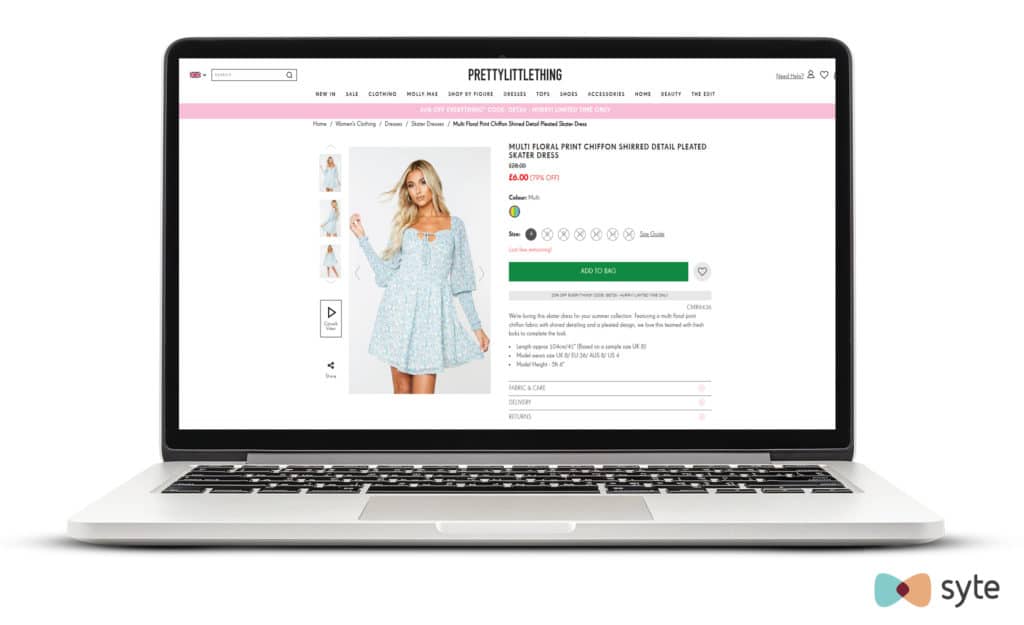Product detail pages (PDP) are the pages that shoppers see when they want in-depth information on specific products on your site. Each product has its own page with complete and relevant details including photos, color and size options, price and sale information, return policies, customer reviews, and more. In most cases, there’s also an “add to cart” or “buy now” button.
Why PDPs Matter
It’s important to note that shoppers usually decide whether or not they want to purchase an item on a PDP, which makes these pages a crucial part of your site. To enhance the customer experience on these critical pages, make sure that you carefully arrange and optimize PDPs so that they intuitively provide all the information shoppers need to make their purchase decision with confidence. Done successfully, product detail pages can boost user interest and lead to successful transactions.
 PrettyLittleThing’s product detail page
PrettyLittleThing’s product detail page
PDP Design and Best Practices
Personalization — PDPs are the centerpiece of the online shopping experience. That makes them one of the best locations on your site to include relevant recommendations, such as visually similar items and complementary products that are commonly bought together. By providing a personalized shopping experience with highly relevant product suggestions, you can increase checkout completions and inspire long-term confidence and brand loyalty.
Mobile-friendly design — More than half of all eCommerce sales originate from mobile devices, which makes it crucial to design your product detail pages with mobile users in mind. Smartphones, in particular, have screens with limited real estate, and users who expect a frictionless and quick experience with as few clicks as possible.
Essential elements to include — Considering the factors above, here are the essential elements and best practices that you should consider to make the most out of your product detail pages:
- Menu navigation: Enable users to navigate seamlessly across your site.
- Search bar: Allow users to search for specific items they have in mind.
- Breadcrumbs: Show the path a user went through to land on a specific PDP.
- Product details: Build trust and confidence in the item by including all relevant information, such as:
- Name – List the full name of the product the shopper is viewing.
- Brand – If it’s a marketplace, make it easy for to shoppers identify the brand they’re looking at.
- Price – Clearly list how much an item costs and show any savings from sales or markdowns.
- Size/Color – Enable users to easily choose any size or color.
- Images – Make sure photos are high quality and taken from different angles.
- Availability – Show right away if items are available or not, and the quantity a user can buy per product.
- Call-to-action: Push users down the funnel with relevant buttons like “add to cart,” “add to wishlist,” or “buy now.”
- Fulfillment options: Inform shoppers of timelines and ways they can receive your products (e.g. standard or same-day shipping, and buy online pick up in-store).
- Return and exchange policy: Be transparent about what users must do if they want to return or exchange items.
- Payment options: Offer shoppers various ways to pay (e.g. PayPal, Venmo, Apple Pay, Google Pay, etc.).
- Customer service queries: Provide users with multiple ways to contact you if they have questions or want to better understand your products.
- Virtual consultations – Set up one-on-one calls for a more personal approach.
- Chatbot – Offer quick tips and answers to frequently asked questions.
- Recommendation engines: Keep product discovery going and shoppers engaged with strategic product suggestions that match their real-time intent.
- View similar – Enable shoppers to find visually similar items to the PDP they are currently viewing.
- Recently viewed – Allow users to see previously clicked items.
- Shop the look – Help shoppers find other products within a PDP photo, such as the shoes on a model displaying a specific pair of jeans or the floor rug in front of a couch.
- Social proof: Highlight user-generated content to build trust and foster relatability.
- Customer reviews – Give users the ability to rank or filter reviews based on star ratings or media availability.
- User-generated photos – Catch the attention of users with content from fellow shoppers who already purchased the item being viewed.
Check out this video for a comprehensive list of tips and tricks to optimize PDPs and drive conversion: